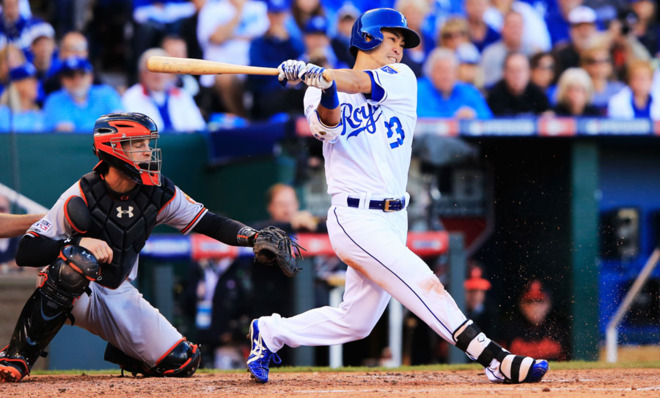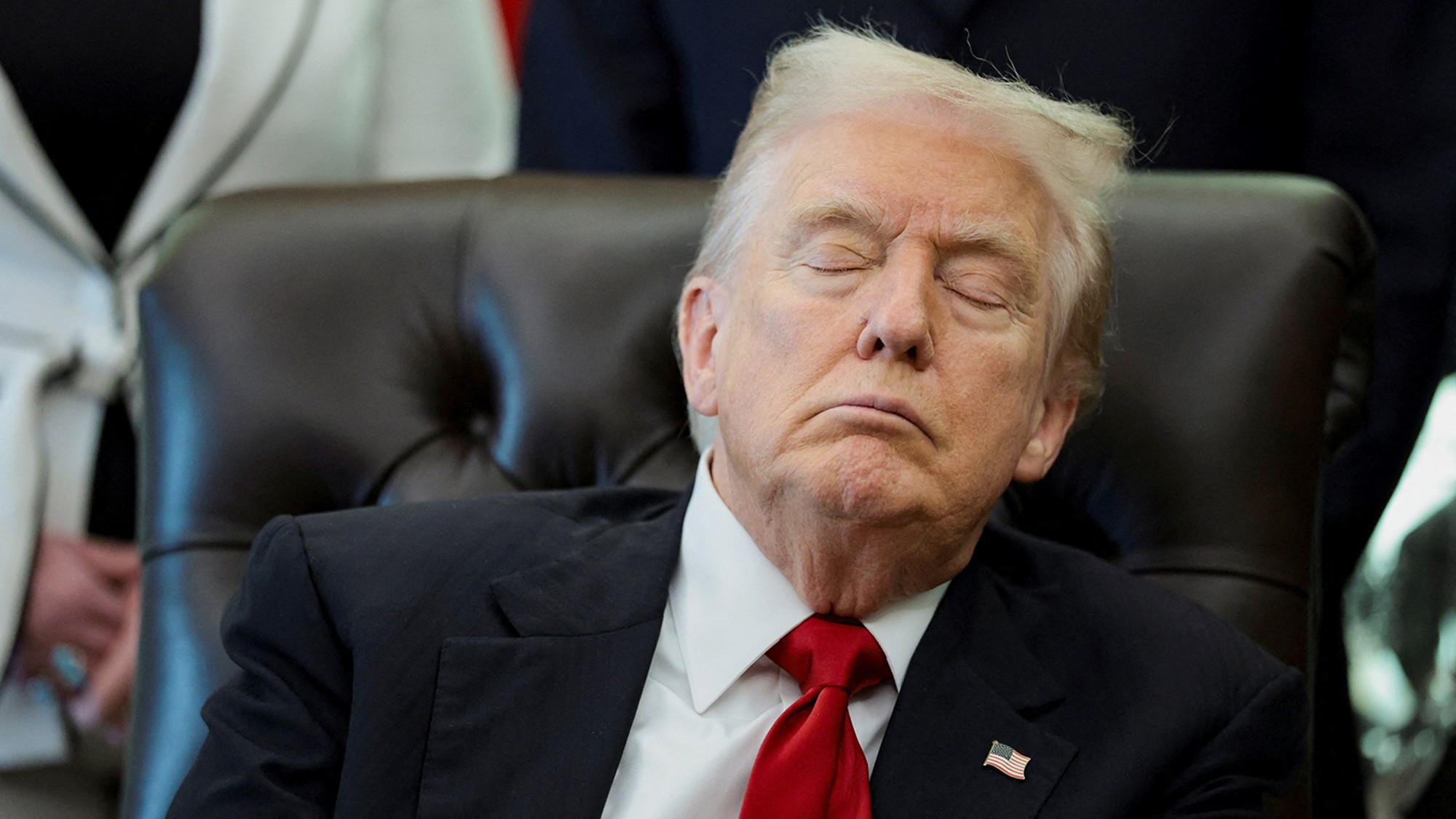Baseball's new secret to success: Don't strike out
A skyrocketing strikeout rate has teams reconsidering their love of the long ball


The Kansas City Royals are not, as some have suggested, the future of baseball. They are a flawed team that squeaked into the playoffs with only 89 wins and a healthy bit of luck. They outperformed their expected record by five games, third-highest in the majors, and their offense rated out as 6 percent worse than the league average this year.
Yet the Royals are indeed on the forefront of a new baseball wave in one crucial respect: They refuse to strike out.
"Don't strike out" may seem like a facile maxim, as obvious a suggestion as telling a team to blast a bunch of homers. Yet in baseball's new high-strikeout, low-offense era, there is a renewed interest in players who can reliably put the ball in play.
The Week
Escape your echo chamber. Get the facts behind the news, plus analysis from multiple perspectives.

Sign up for The Week's Free Newsletters
From our morning news briefing to a weekly Good News Newsletter, get the best of The Week delivered directly to your inbox.
From our morning news briefing to a weekly Good News Newsletter, get the best of The Week delivered directly to your inbox.
Following the steroid-fueled homer bonanza of the 1990s and early 2000s, offense across the game has plummeted. Teams averaged 4.07 runs per game in 2014, the lowest level since 1981 and a steep drop from a peak of 5.14 in 2000. The league collectively batted .251 this season, the worst mark since 1972.
Meanwhile, pitchers in 2014 struck out an average of 7.7 batters per game — the highest rate ever, and a rate that has risen for nine straight seasons.
There are a number of ways to explain this phenomenon. The advent of pitch-tracking technology has forced umps to call more consistent — and, importantly, larger — strike zones. Teams are stockpiling flame-throwing pitchers; the number of hurlers who average at least a 95-mph fastball has tripled since 2007. The league has generally come to accept the feast-or-famine tradeoff of more whiffs for more homers. And of course, tighter drug-testing protocols imposed in the past decade have probably contributed to a power outage.
This trend has eroded the effectiveness of a strategy that the Moneyball A's made famous: stacking a lineup with on-base machines and sluggers, then praying for three-run bombs. So to counter the strikeout epidemic, forward-thinking teams are putting more emphasis on the simple skill of putting the ball in play.
A free daily email with the biggest news stories of the day – and the best features from TheWeek.com
The newfound importance of making contact represents something of a "new, old market inefficiency," ESPN's Tommy Rancel wrote back in May. Though OBP remains king among offensive stats, contact rate and batting average are getting a second look. As Rancel noted, two teams consistently ahead of the curve when it comes to exploiting inefficiencies in the game, the A's and Rays, have aggressively targeted contact hitters and dramatically slashed their strikeout rates over the past few years.
"Putting the ball in play may not sweep the league back to the 1980s," he wrote, but if more teams follow suit, "it is likely a continued attempt to swing back at the punchout."
Which brings us back to the Royals.
Kansas City posted the lowest strikeout rate in the league this year, with its hitters going down by way of the K in only 16.3 percent of their plate appearances. (The aforementioned Rays and A's notched the next-best marks at 18.1 percent and 17.7 percent, respectively.) And the team's hitters made contact 82.7 percent of the time they swung the bat, second best in the league.
That strategy plays perfectly into the Royals' unrivaled running game. Putting the ball in play forces the opposing defense to make an out, and to do so quickly when a speedster is flying toward first. (It's no coincidence the Royals tied for third in the league with 141 infield hits this year.) Once runners are safely on base, then it's off to the races for a team that swiped a league-leading 153 bags on the year. And all that speed has allowed Royals base runners to scamper around the diamond whenever a teammate puts the ball in play, picking up extra bases and giving them more chances to score runs.
Though the Royals' strikeout rate has ticked up in the postseason, it's remained well below the league average. And as we've seen, it's helped them scratch out crucial runs in close games. Perhaps the best example came in the wild-card game, in which a stolen base and a sacrifice fly plated the tying run in the bottom of the ninth. The guy who lofted that sac fly? Outfielder Nori Aoki, who conveniently flashed the fifth-lowest strikeout rate in the game this year.
After posting a middling strikeout rate in the regular season, the Giants have gone stingy on that front as well in the postseason. Their 14.2 percent strikeout rate in October is the lowest among any playoff team. Though the results have been slow to show, hitting coach Hensley Meulens preached a contact-first approach to several hitters this year, instructing them to go for a more level swing instead of a homer-happy uppercut.
"That's why we've evolved to putting the ball in play and creating something," Meulens told The Wall Street Journal. "If you hit a home run, it's a bonus."
Deliberately eschewing strikeouts in favor of weaker contact does have its limitations. Teams can't always rely on opposing defenses to literally throw away games with errors. Both the Royals and Giants play in pitcher-friendly parks where long balls are scarce and slap-hit bloopers have more room to drop. A lineup stacked with free-swinging sluggers might make more sense in, say, Yankee Stadium, with its notoriously short right-field fence.
It's also worth noting that the Royals have averaged the best strikeout rate in the game since 2010 but have made the playoffs just once. And last year, the Red Sox won it all while striking out 20.5 percent of the time — ninth highest in the game — indicating that there's more than one effective strategy to winning a title.
Antiquated small ball is unlikely to once again dominate the game, with every team routinely bunting away outs and players sporting outdated stirrups. But if the Royals continue their dream run to a World Series title, you can bet more teams will retool their lineups with a less slavish devotion to homers and an increased desire to slash their strikeout rates, too.
Jon Terbush is an associate editor at TheWeek.com covering politics, sports, and other things he finds interesting. He has previously written for Talking Points Memo, Raw Story, and Business Insider.
-
 Is $140,000 the real poverty line?
Is $140,000 the real poverty line?Feature Financial hardship is wearing Americans down, and the break-even point for many families keeps rising
-
 Film reviews: ‘The Secret Agent’ and ‘Zootopia 2’
Film reviews: ‘The Secret Agent’ and ‘Zootopia 2’Feature A Brazilian man living in a brutal era seeks answers and survival and Judy and Nick fight again for animal justice
-
 Trump: Losing energy and support
Trump: Losing energy and supportFeature Polls show that only one of his major initiatives—securing the border—enjoys broad public support
